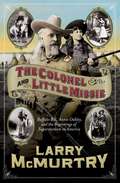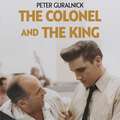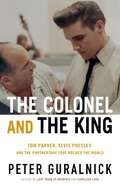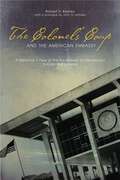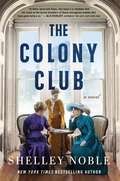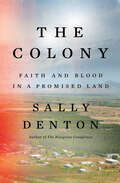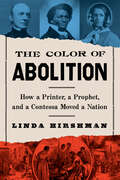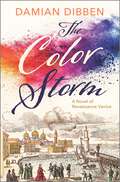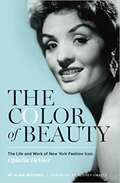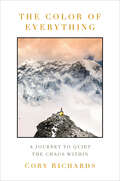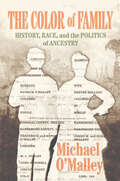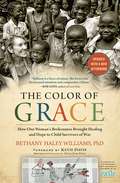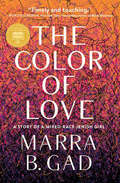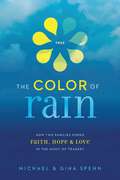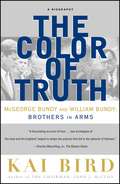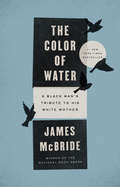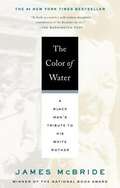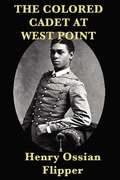- Table View
- List View
The Colonel and Little Missie: Buffalo Bill, Annie Oakley, and the Beginnings of Superstardom in America
by Larry McmurtryLarry McMurtry is the author of twenty-seven novels, including the Pulitzer Prize-winning Lonesome Dove. His other works include two collections of essays, three memoirs and more than thirty screenplays.
The Colonel and the King: Tom Parker, Elvis Presley and the Partnership that Rocked the World
by Peter GuralnickIn early 1955, Colonel Tom Parker (the manager of the number-one country music star of the day) heard that an unknown teenager from Memphis had just drawn a crowd of more than 800 people to a Texas schoolhouse and headed south to investigate. Within a matter of days, Parker was sending out telegrams and letters to promoters and booking agents: 'We have a new boy that is absolutely going to be one of the biggest things in the business in a very short time. His name is ELVIS PRESLEY.' The close personal bond between Elvis and the Colonel is something that has never been fully portrayed before. It was a relationship founded on mutual admiration and support. From the outset, the Colonel defended Elvis fiercely and indefatigably against RCA executives, Elvis' own booking agents and movie moguls. But in their final years together, the story grew darker, as the Colonel found himself unable to protect Elvis from himself - or to control growing problems of his own. Featuring troves of previously unpublished correspondence from the Colonel's own archives, revelatory for both their insights and their emotional depth, The Colonel and the King provides a groundbreaking dual portrait of the relationship between the iconic artist and his legendary manager and a unique perspective on not one but two American originals. A tale of the birth of the modern-day superstar (an invention almost entirely of Parker's making) by the most acclaimed music writer of his generation, it presents these two misunderstood icons as they've never been seen before: with all of their brilliance, humour and flaws on full display.
The Colonel and the King: Tom Parker, Elvis Presley and the Partnership that Rocked the World
by Peter GuralnickIn early 1955, Colonel Tom Parker (the manager of the number-one country music star of the day) heard that an unknown teenager from Memphis had just drawn a crowd of more than 800 people to a Texas schoolhouse and headed south to investigate. Within a matter of days, Parker was sending out telegrams and letters to promoters and booking agents: 'We have a new boy that is absolutely going to be one of the biggest things in the business in a very short time. His name is ELVIS PRESLEY.' The close personal bond between Elvis and the Colonel is something that has never been fully portrayed before. It was a relationship founded on mutual admiration and support. From the outset, the Colonel defended Elvis fiercely and indefatigably against RCA executives, Elvis' own booking agents and movie moguls. But in their final years together, the story grew darker, as the Colonel found himself unable to protect Elvis from himself - or to control growing problems of his own. Featuring troves of previously unpublished correspondence from the Colonel's own archives, revelatory for both their insights and their emotional depth, The Colonel and the King provides a groundbreaking dual portrait of the relationship between the iconic artist and his legendary manager and a unique perspective on not one but two American originals. A tale of the birth of the modern-day superstar (an invention almost entirely of Parker's making) by the most acclaimed music writer of his generation, it presents these two misunderstood icons as they've never been seen before: with all of their brilliance, humour and flaws on full display.
The Colonel and the King: Tom Parker, Elvis Presley, and the Partnership that Rocked the World
by Peter GuralnickFrom the award-winning biographer of Elvis Presley, a groundbreaking dual portrait of the relationship between the iconic artist and his legendary manager—drawing on a wealth of the Colonel's never-before-seen correspondence to reveal that this oft-reviled figure was in fact a confidant, friend, and architect of his client&’s success In early 1955, Colonel Tom Parker—manager of the number-one country music star of the day—heard that an unknown teenager from Memphis had just drawn a crowd of more than eight hundred people to a Texas schoolhouse, and headed south to investigate. Within days, Parker was sending out telegrams and letters to promoters and booking agents: &“We have a new boy that is absolutely going to be one of the biggest things in the business in a very short time. His name is ELVIS PRESLEY.&” Later that year, after signing with RCA, the young man sent a telegram of his own: &“Dear Colonel, Words can never tell you how my folks and I appreciate what you did for me.... I love you like a father.&” The close personal bond between Elvis and the Colonel has never been fully portrayed before. It was a relationship founded on mutual admiration and support. From the outset, the Colonel defended Elvis fiercely and indefatigably against RCA executives, Elvis&’s own booking agents, and movie moguls. But in their final years together, the story grew darker, as the Colonel found himself unable to protect Elvis from himself or control growing problems of his own. Featuring troves of previously unpublished correspondence, revelatory for both its insights and emotional depth, The Colonel and the King provides a unique perspective on not one but two American originals. A tale of the birth of the modern-day superstar (an invention almost entirely of Parker&’s making) by Peter Guralnick, the most acclaimed music writer of his generation, it presents these two misunderstood icons as they&’ve never been seen before: with all of their brilliance, humor, and flaws on full display.
The Colonel of Tamarkan: Philip Toosey and the Bridge on the River Kwai
by Julie SummersAlec Guinness won a Best Actor Oscar for his portrayal of the dogmatic but brittle commanding officer in David Lean's film "The Bridge on the River Kwai". While a brilliant performance, it owed more to fiction than fact, as the man who actually commanded the POWs ordered to build the infamous bridges -- there were in fact two: one wooden, one concrete -- was cut from very different cloth. Lieutenant Colonel Philip Toosey was the senior officer among the 2,000-odd Allied servicemen incarcerated in Tamarkan prison camp, and as such had to comply with the Japanese orders to help construct their Thailand-Burma railway. With malnutrition, disease and brutality their constant companions, it was a near-impossible task for soldiers who had already endured terrible privations -- and one which they knew would be in the service of their enemy. But under Toosey's careful direction, a subtle balancing act between compliance and subversion, the Allied inmates not only survived but regained some sense of self-respect. Re-creating the story of this remarkable leader with tremendous skill and narrative flair, and drawing on many original interviews with Second World War POWs from the Asian theatre, THE COLONEL OF TAMARKAN is a riveting blend of biography and history.
The Colonel: The Extraordinary Story of Colonel Tom Parker and Elvis Presley
by Alanna NashIn The Colonel, Alanna Nash, the author of Golden Girl: The Story of Jessica Savitch, explores in depth the amazing story of Colonel Tom Parker, the man behind the legend and the myth of Elvis Presley. The result is a book that reads like the most riveting of real-life detective stories -- one that will completely change your view of Presley's life, success, and death. While scores of books have been written about Elvis Presley, this is the first meticulously researched biography of Tom Parker written by someone who knew him personally. And for anyone truly interested in the performer many consider the greatest and most influential of the twentieth century, it is impossible to understand how Elvis came to be such a phenomenon without examining the life and mind of Parker, the man who virtually controlled Elvis's every move. Alanna Nash has been covering the story of Elvis Presley and Colonel Tom Parker since the day of Presley's funeral in Memphis, Tennessee. She was the first journalist allowed to view Presley's body, a compelling and surprising sight. But the profile of Parker attending the funeral in a Hawaiian shirt and a baseball cap was even stranger, and led her to investigate the man behind the myth. It has been known for twenty years that Thomas Andrew Parker was, in fact, born in Holland as Andreas Cornelis van Kuijk. But Nash has dug much deeper and, in a masterpiece of reporting, unearthed never-before-seen documents, including Parker's army records and psychiatric evaluations, and the original police report of an unsolved murder case in Holland that lies at the heart of the Parker mystery. In the process of weighing the evidence, she answers the biggest riddle in the history of the music industry, as it becomes clear that every move Parker made in the handling of Elvis Presley -- from why he never allowed Elvis to perform in Europe, to why he didn't halt Elvis's drug use, to why he put him in so many mediocre movies, and even the Colonel's direction of Presley's army career -- was designed to protect Parker's own secrets. Filled with startling new material, her book challenges even the most familiar precepts of the Presley saga -- everything we presumed about Parker's handling of the world's most famous entertainer must now be reevaluated in the light of information Nash reveals about Parker, who cared little for Presley beyond what the singer could do to bolster the Colonel's precarious position as an illegal alien. Elvis Presley, as one of Parker's unwitting victims, paid a major price for the Colonel's past and his overwhelming need to be more important than his client. As a result, Presley was never allowed to reach his potential and died in drug-induced frustration over his stunted and mismanaged career. In this astonishing, impeccably written, and vastly entertaining book, Nash proves that the only figure in American popular culture as fascinating as Elvis Presley is Colonel Tom Parker, the man who shaped Elvis, who in turn helped shape us.
The Colonels’ Coup and the American Embassy: A Diplomat’s View of the Breakdown of Democracy in Cold War Greece (ADST-DACOR Diplomats and Diplomacy Series)
by John O. Iatrides Robert V. KeeleyRobert Keeley was a Foreign Service officer stationed in Greece during one of the most tumultuous events in the country’s history, the so-called Colonels’ coup of April 21, 1967. This is his insider’s account of how U.S. policy was formulated, debated, and implemented from 1966 to 1969, the critical years directly before and after the coup. A major event in the history of the Cold War, the coup ushered in a seven-year period of military rule in Greece. In its wake, some eight thousand people affiliated with the Communist Party were rounded up, and Greece became yet another country where the fear of Communism led the United States into alliance with a repressive right-wing authoritarian regime. In military coups in some other countries, it is known that the CIA and other agencies of the U.S. government played an active role in encouraging and facilitating the takeover. The Colonels’ coup, however, came as a surprise to the United States (which was expecting a Generals’ coup instead). Yet the U.S. government accepted it after the fact, despite internal disputes within policymaking circles about the wisdom of accommodating the upstart Papadopoulos regime. Keeley was among those dissenters.
The Colony Club: A Novel
by Shelley NobleFrom New York Times bestselling author Shelley Noble comes a thrilling historical novel about the inception of the Colony Club, the first women’s club of its kind, set against the dazzling backdrop of Gilded Age New York. When young Gilded Age society matron Daisy Harriman is refused a room at the Waldorf because they don’t cater to unaccompanied females, she takes matters into her own hands. She establishes the Colony Club, the first women’s club in Manhattan, where visiting women can stay overnight and dine with their friends; where they can discuss new ideas, take on social issues, and make their voices heard. She hires the most sought-after architect in New York, Stanford White, to design the clubhouse.As “the best dressed actress on the Rialto” Elsie de Wolfe has an eye for décor, but her career is stagnating. So when White asks her to design the clubhouse interiors, she jumps at the chance and the opportunity to add a woman’s touch. He promises to send her an assistant, a young woman he’s hired as a draftsman.Raised in the Lower East Side tenements, Nora Bromely is determined to become an architect in spite of hostility and sabotage from her male colleagues. She is disappointed and angry when White “foists” her off on this new women’s club project.But when White is murdered and the ensuing Trial of the Century discloses the architect’s scandalous personal life, fearful backers begin to withdraw their support. It’s questionable whether the club will survive long enough to open.Daisy, Elsie, and Nora have nothing in common but their determination to carry on. But to do so, they must overcome not only society’s mores but their own prejudices about women, wealth, and each other. Together they strive to transform Daisy’s dream of the Colony Club into a reality, a place that will nurture social justice and ensure the work of the women who earned the nickname “Mink Brigade” far into the future.
The Colony: Faith And Blood In A Promised Land
by Sally DentonA Publishers Weekly Summer Reads Selection “The Colony is one of the most gripping and disturbing true stories I’ve ever come across.” —Douglas Preston An investigation into the November, 2019 killings of nine women and children in Northern Mexico—an event that drew international attention—The Colony examines the strange, little-understood world of a polygamist Mormon outpost. On the morning of November 4, 2019, an unassuming caravan of women and children was ambushed by masked gunmen on a desolate stretch of road in northern Mexico controlled by the Sinaloa drug cartel. Firing semi-automatic weapons, the attackers killed nine people and gravely injured five more. The victims were members of the LeBaron and La Mora communities—fundamentalist Mormons whose forebears broke from the LDS Church and settled in Mexico when their religion outlawed polygamy in the late nineteenth century. The massacre produced international headlines for weeks, and prompted President Donald Trump to threaten to send in the US Army. In The Colony, bestselling investigative journalist Sally Denton picks up where the initial, incomplete reporting on the attacks ended, and delves into the complex story of the LeBaron clan. Their homestead—Colonia LeBaron—is a portal into the past, a place that offers a glimpse of life within a polygamous community on an arid and dangerous frontier in the mid-1800s, though with smartphones and machine guns. Rooting her narrative in written sources as well as interviews with anonymous women from LeBaron itself, Denton unfolds an epic, disturbing tale that spans the first polygamist emigrations to Mexico through the LeBarons’ internal blood feud in the 1970s—started by Ervil LeBaron, known as the “Mormon Manson”—and up to the family’s recent alliance with the NXIVM sex cult, whose now-imprisoned leader, Keith Raniere, may have based his practices on the society he witnessed in Colonia LeBaron. The LeBarons’ tense but peaceful interactions with Sinaloa deteriorated in the years leading up to the ambush. LeBaron patriarchs believed they were deliberately targeted by the cartel. Others suspected that local farmers had carried out the attacks in response to the LeBarons’ seizure of water rights for their massive pecan orchards. As Denton approaches answers to who committed the murders, and why, The Colony transforms into something more than a crime story. A descendant of polygamist Mormons herself, Denton explores what drove so many women over generations to join or remain in a community based on male supremacy and female servitude. Then and now, these women of Zion found themselves in an isolated desert, navigating the often-mysterious complications of plural marriage—and supported, Denton shows, only by one another. A mesmerizing feat of investigative journalism, The Colony doubles as an unforgettable account of sisterhood that can flourish in polygamist communities, against the odds.
The Color Of Abolition: How a Printer, a Prophet, and a Contessa Moved a Nation
by Linda HirshmanThe story of the fascinating, fraught alliance among Frederick Douglass, William Lloyd Garrison, and Maria Weston Chapman—and how its breakup led to the success of America's most important social movement In the crucial early years of the Abolition movement, the Boston branch of the cause seized upon the star power of the eloquent ex-slave Frederick Douglass to make its case for slaves&’ freedom. Journalist William Lloyd Garrison promoted emancipation while Garrison loyalist Maria Weston Chapman, known as &“the Contessa,&” raised money and managed Douglass&’s speaking tour from her Boston townhouse. Conventional histories have seen Douglass&’s departure for the New York wing of the Abolition party as a result of a rift between Douglass and Garrison. But, as acclaimed historian Linda Hirshman reveals, this completely misses the woman in power. Weston Chapman wrote cutting letters to Douglass, doubting his loyalty; the Bostonian abolitionists were shot through with racist prejudice, even aiming the N-word at Douglass among themselves. Through incisive, original analysis, Hirshman convinces that the inevitable breakup was in fact a successful failure.Eventually, as the most sought-after Black activist in America, Douglass was able to dangle the prize of his endorsement over the Republican Party&’s candidate for President, Abraham Lincoln. Two years later the abolition of slavery—if not the abolition of racism—became immutable law.
The Color Storm: A Novel of Renaissance Venice
by Damian DibbenEnter the world of Renaissance Venice, where the competition for fame and fortune can mean life or death…Artists flock here, not just for wealth and fame, but for revolutionary color. Yet artist Giorgione &“Zorzo&” Barbarelli&’s career hangs in the balance. Competition is fierce, and his debts are piling up. When Zorzo hears a rumor of a mysterious new pigment, brought to Venice by the richest man in Europe, he sets out to acquire the color and secure his name in history.Winning a commission to paint a portrait of the man&’s wife, Sybille, Zorzo thinks he has found a way into the merchant&’s favor. Instead he finds himself caught up in a conspiracy that stretches across Europe and a marriage coming apart inside one of the floating city&’s most illustrious palazzi.As the water levels rise and the plague creeps ever closer, an increasingly desperate Zorzo isn&’t sure whom he can trust. Will Sybille prove to be the key to Zorzo&’s success or the reason for his downfall?Atmospheric and suspenseful and filled with the famous artists of the era, The Color Storm is an intoxicating story of art and ambition, love and obsession.
The Color of Atmosphere
by Maggie KozelKozel, a graduate of Georgetown University School of Medicine in 1980, spent the first 10 years of her medical career as a physician in the US military, with its universal, single-payer health coverage offering every family the same access to the latest health care. In this memoir for general readers, she recounts with warmth and humor her journey from idealistic young pediatrician to the culture shock of private practice outside the military. Her personal story is told in the context of the changing healthcare system, focusing on how the current method of paying for health care has changed the way doctors practice, not for the better. Kozel, now a high school teacher, argues that the profession is currently shaped by health insurance reimbursements and pharmaceutical marketing rather than by science. The book will be of interest to those working in the medical profession, those considering it, and general readers. Annotation ©2011 Book News, Inc. , Portland, OR (booknews. com)
The Color of Beauty: The Life and Work of New York Fashion Icon Ophelia Devore
by Audrey SmaltzOphelia DeVore boldly overcame tragedy and hardship to become the first black model in the United States of America. She possessed grace, finesse, intelligence, natural beauty, and courage. Being the first black graduate of the Vogue Modeling School, she eventually became a powerful business mogul, an exuberant entrepreneur, and a respected leader in her field. Her story is unique because she redefined “beauty” in America. Throughout her life, she sought to prove to the world beauty could be found in every shade of color. <p><p> The Ophelia DeVore Charm School and Grace Del Marco Modeling Agency served as a strong foundation for notables including Diahann Carroll, Richard Roundtree, Trudy Haynes, Helen Williams, Cicely Tyson, Susan Taylor, Audrey Smaltz and many more. She regularly worked with fashion icons such as Christian Dior, Ralph Lauren, and Ceil Chapman. In a personal letter written on July 17, 1967, Dr. Martin Luther King, Jr., thanked DeVore for being a part of “the great democratic crusade of our era.” Her inspirational story will move you to believe in yourself and achieve your dreams.
The Color of Everything: A Journey to Quiet the Chaos Within
by Cory RichardsA renowned climber and National Geographic photographer shares his incredible adventures—and the early trauma that drove him to seek such heights.&“An extraordinary memoir of mental illness that reads like a thriller.&”—Amy Ellis Nutt, Pulitzer Prize–winning journalist and author of Becoming Nicole&“In order to escape madness, I will live madly. I will risk my life in order to save it.&”Growing up in the mountains of Utah, Cory Richards was constantly surrounded by the outdoors. His father, a high school teacher and a ski patroller, spent years teaching Richards and his brother how to ski, climb, mountaineer, and survive in the wild. Despite a seemingly idyllic childhood, the Richards home was fraught with violence, grief, and mental illness. After being diagnosed with bipolar disorder and dropping out of high school, Richards subsumed himself in the worlds of photography and climbing, seeking out the farthest reaches of the world to escape the darkness. Then, in the midst of a wildly successful career in adventure photography, a catastrophic avalanche changed everything, forcing Richards to confront the trauma of his past, evaluate his own mental health, and learn to rewrite his story.The Color of Everything is a thrilling tale of risk and adventure, written by a man who has done it all: He&’s stood at the top of the world, climbed imposing mountain faces alone in the dark, and become the only American to summit an 8,000-meter peak in winter. But it is also the story of a tumultuous life—a stirring, lyrical memoir that captures the profound musings of an unquiet mind grappling with the meaning of success, the cost of fame and addiction, and whether it is possible to outrun your demons. With exquisite prose and disarming candor, accompanied by stunning photos from his career, Richards excavates the roots of his trauma and shares what it took for him to climb out of it.
The Color of Family: History, Race, and the Politics of Ancestry
by Michael O'MalleyA uniquely blended personal family history and history of the changing definitions of race in America. A zealous eugenicist ran Virginia’s Bureau of Vital Statistics in the first half of the twentieth century, misusing his position to reclassify people he suspected of hiding their “true” race. But in addition to being blinded by his prejudices, he and his predecessors were operating more by instinct than by science. Their whole dubious enterprise was subject not just to changing concepts of race but outright error, propagated across generations. This is how Michael O’Malley, a descendant of a Philadelphia Irish American family, came to have “colored” ancestors in Virginia. In The Color of Family, O’Malley teases out the various changes made to citizens’ names and relationships over the years, and how they affected families as they navigated what it meant to be “white,” “colored,” “mixed race,” and more. In the process, he delves into the interplay of genealogy and history, exploring how the documents that establish identity came about, and how private companies like Ancestry.com increasingly supplant state and federal authorities—and not for the better. Combining the history of O’Malley’s own family with the broader history of racial classification, The Color of Family is an accessible and lively look at the ever-shifting and often poisoned racial dynamics of the United States.
The Color of Grace
by Katie J. Davis Beth Clark Bethany Haley WilliamsA middle-class woman in rural America and war-affected children in Africa find common ground in their journeys from brokenness to redemption.Author and psychologist Bethany Haley Williams shares how her own emotional healing led her into treacherous war zones, where she provides care to former child soldiers and young girls used as sex slaves. Faced with her own battle with shame and a rocky journey toward healing, Bethany founded Exile International, a non-profit that implements art/expressive therapy and long-term, rehabilitative care to restore and empower war-affected children--including children rescued from Joseph Kony's LRA (Lord's Resistance Army). One of those rescued young men, Solomon, was abducted at the age of ten after being forced to watch LRA soldiers maim and murder his father and grandfather. His younger siblings were left behind, and his mother was instructed to "raise them well...for one day we'll return to take them too." Solomon is one of hundreds of thousands of boys and girls who have had their innocence stolen and are forced to do the unthinkable on a daily basis. But their horrific experiences are just the beginning. The real story is what happens after. Once these children learn to face their pasts, they are given hope for a future and a vision for changing the fabric of their countries by becoming leaders for peace and advocates of the power of forgiveness. of forgiveness. "If the world could learn forgiveness, resilience, and joy to this level, it would be radically changed. And these young survivors would be our greatest teachers." --Bethany Haley
The Color of Love: A Story of a Mixed-Race Jewish Girl
by Marra B. GadIn this award-winning memoir, a mixed-race Jewish woman recounts her journey from adoption and prejudice to helping the family that once shunned her.Marra B. Gad’s biological parents were a black man and a white Jewish woman. In 1970, at three days old, she was adopted by a white Jewish family in Chicago. For them, it was love at first sight—but the world was not ready for a family like theirs. In black spaces, Marra was considered “not black enough” and encountered antisemitism. In Jewish spaces, she was mistaken for the help, asked to leave, or worse. She even faced racism within her own family.Marra’s family cut ties with relatives who refused to accept her—including her once beloved and glamorous Great-Aunt Nette. But after fifteen years of estrangement, Marra discovered that Nette had Alzheimer’s, and that she was the only one able to reunite Nette with her family. Instead of revenge, Marra chose love, and watched as the disease erased her aunt’s racism, making space for a relationship that was never possible before.The Color of Love explores the idea of yerusha, which means “inheritance” in Yiddish. At turns heart-wrenching and heartwarming, this is a story about what you inherit from your family—identity, disease, melanin, hate, and most powerful of all, love.Winner of the 2020 Midwest Book Award in Autobiography/Memoir
The Color of Rain: How Two Families Found Faith, Hope, and Love in the Midst of Tragedy
by Gina Kell Spehn Michael SpehnMatt Kell and Cathy Spehn had known each other since grade school. As adults, they each married, lived in their hometown and attended the same church. Their kids attended school together. Matt died at home on Christmas Day after a three-year battle with cancer, leaving behind his wife, Gina, and two young boys. Prior to his death, Matt recorded a video diary for his sons, which included his desire and expectations that their mom would love again. After attending Matt’s inspirational funeral and reaching out to Gina with offers of support, Cathy was diagnosed with inoperable brain cancer. She died only seventeen days later, leaving behind her husband, Michael, and three young children. In her final hours, Cathy instructed Michael to “call Gina Kell.” The Color of Rain illuminates the stepping-stones of loss and healing that ultimately led to a joyful new life for Michael, Gina and their five children. Their path to becoming a modern day Brady Bunch was filled with grief, laughter, and a willingness to be restored to a new and even better life, despite the inevitable resistance they faced. As the dual first-person narrative reveals what it is like to walk through loss and love simultaneously, readers receive an intimate look at how this ordinary group of people lived, died, and ultimately persevered through extraordinary circumstances.
The Color of Time: Women In History: 1850-1960 (The Color of Time)
by Dan JonesBestselling historian Dan Jones and the brilliant artist Marina Amaral have combined their talents to create a illuminating visual history of women around the world.Dan Jones and Marina Amaral, the acclaimed team behind The Color of Time, combine their talents again to explore the many roles—domestic, social, cultural and professional—played by women across the world before second-wave feminism took hold. Using Marina Amaral's colorized images and Dan Jones's words, this survey features women both celebrated and ordinary, whether in the home or the science lab, protesting on the streets or performing on stage, fighting in the trenches or exploring the wild. This vivid and unique history brings to life and full color the female experience in a century of extraordinary change. Each chapter will be introduced by a woman who works in that field today and the book includes photographs of Queen Victoria, Edith Cavell, Josephine Baker, Mildred Burke, Eva Peron, Eleanor Roosevelt, Virginia Woolf, Clara Schumann, Martha Gellhorn, Simone de Beauvoir, Agatha Christie, Frida Kahlo, Emmeline Pankhurst, Harriet Tubman, Florence Nightingale, Hattie McDaniel and Gertrude Bell; as well as revolutionaries from China to Cuba, Geishas in Japan, protestors on the Salt March, teachers and pilots, nurses and soldiers. In combination of vivid pictures and stirring prose, The Color of Time: Women in History, brings history to life from the vantage point of women who lived it.
The Color of Truth: A Biography
by Kai BirdBiographies of two brothers during their careers as statesmen in the late twentieth century.
The Color of Truth: McGeorge Bundy and William Bundy: Brothers in Arms
by Kai Bird"Grey is the color of truth." So observed Mac Bundy in defending America's intervention in Vietnam. Kai Bird brilliantly captures this ambiguity in his revelatory look at Bundy and his brother William, two of the most influential policymakers of the Kennedy and Johnson administrations. It is a portrait of fiercely patriotic, brilliant and brazenly self-confident men who directed a steady escalation of a war they did not believe could be won. Bird draws on seven years of research, nearly one hundred interviews, and scores of still-classified top secret documents in a masterful reevaluation of America's actions throughout the Cold War and Vietnam.
The Color of Water: A Black Man's Tribute To His White Mother (Sparknotes Literature Guide Ser.)
by James McbrideWho is Ruth McBride Jordan? A self-declared "light-skinned" woman evasive about her ethnicity, yet steadfast in her love for her twelve black children. James McBride, journalist, musician, and son, explores his mother's past, as well as his own upbringing and heritage, in a poignant and powerful debut, The Color Of Water: A Black Man's Tribute to His White Mother. <p><p> The son of a black minister and a woman who would not admit she was white, James McBride grew up in "orchestrated chaos" with his eleven siblings in the poor, all-black projects of Red Hook, Brooklyn. "Mommy," a fiercely protective woman with "dark eyes full of pep and fire," herded her brood to Manhattan's free cultural events, sent them off on buses to the best (and mainly Jewish) schools, demanded good grades, and commanded respect. As a young man, McBride saw his mother as a source of embarrassment, worry, and confusion—and reached thirty before he began to discover the truth about her early life and long-buried pain. <p> In The Color of Water, McBride retraces his mother's footsteps and, through her searing and spirited voice, recreates her remarkable story. The daughter of a failed itinerant Orthodox rabbi, she was born Rachel Shilsky (actually Ruchel Dwara Zylska) in Poland on April 1, 1921. Fleeing pogroms, her family emigrated to America and ultimately settled in Suffolk, Virginia, a small town where anti-Semitism and racial tensions ran high. With candor and immediacy, Ruth describes her parents' loveless marriage; her fragile, handicapped mother; her cruel, sexually-abusive father; and the rest of the family and life she abandoned. <p> At seventeen, after fleeing Virginia and settling in New York City, Ruth married a black minister and founded the all- black New Brown Memorial Baptist Church in her Red Hook living room. "God is the color of water," Ruth McBride taught her children, firmly convinced that life's blessings and life's values transcend race. Twice widowed, and continually confronting overwhelming adversity and racism, Ruth's determination, drive and discipline saw her dozen children through college—and most through graduate school. At age 65, she herself received a degree in social work from Temple University. <p> Interspersed throughout his mother's compelling narrative, McBride shares candid recollections of his own experiences as a mixed-race child of poverty, his flirtations with drugs and violence, and his eventual self- realization and professional success. The Color of Water touches readers of all colors as a vivid portrait of growing up, a haunting meditation on race and identity, and a lyrical valentine to a mother from her son.
The Color of Water: A Black Man's Tribute to His White Mother
by James Mcbride<P>Who is Ruth McBride Jordan? A self-declared "light-skinned" woman evasive about her ethnicity, yet steadfast in her love for her twelve black children. <P>James McBride, journalist, musician, and son, explores his mother's past, as well as his own upbringing and heritage, in a poignant and powerful debut,The Color Of Water: A Black Man's Tribute to His White Mother. <P>The son of a black minister and a woman who would not admit she was white, James McBride grew up in "orchestrated chaos" with his eleven siblings in the poor, all-black projects of Red Hook, Brooklyn. <P>"Mommy," a fiercely protective woman with "dark eyes full of pep and fire," herded her brood to Manhattan's free cultural events, sent them off on buses to the best (and mainly Jewish) schools, demanded good grades, and commanded respect. <P>As a young man, McBride saw his mother as a source of embarrassment, worry, and confusion-and reached thirty before he began to discover the truth about her early life and long-buried pain. <P> In The Color of Water, McBride retraces his mother's footsteps and, through her searing and spirited voice, recreates her remarkable story. The daughter of a failed itinerant Orthodox rabbi, she was born Rachel Shilsky (actually Ruchel Dwara Zylska) in Poland on April 1, 1921. <P>Fleeing pogroms, her family emigrated to America and ultimately settled in Suffolk, Virginia, a small town where anti-Semitism and racial tensions ran high. <P>With candor and immediacy, Ruth describes her parents' loveless marriage; her fragile, handicapped mother; her cruel, sexually-abusive father; and the rest of the family and life she abandoned. <P>At seventeen, after fleeing Virginia and settling in New York City, Ruth married a black minister and founded the all- black New Brown Memorial Baptist Church in her Red Hook living room. "God is the color of water," Ruth McBride taught her children, firmly convinced that life's blessings and life's values transcend race. <P>Twice widowed, and continually confronting overwhelming adversity and racism, Ruth's determination, drive and discipline saw her dozen children through college-and most through graduate school. <P>At age 65, she herself received a degree in social work from Temple University. <P>Interspersed throughout his mother's compelling narrative, McBride shares candid recollections of his own experiences as a mixed-race child of poverty, his flirtations with drugs and violence, and his eventual self- realization and professional success. <P>The Color of Water touches readers of all colors as a vivid portrait of growing up, a haunting meditation on race and identity, and a lyrical valentine to a mother from her son.
The Colored Cadet at West Point
by Henry Ossian FlipperHenry Ossian Flipper (21 March 1856 - 3 May 1940) was an American soldier, former slave, and the first African American to graduate from the United States Military Academy at West Point in 1877, earning a commission as a 2nd Lieutenant in the US Army.
